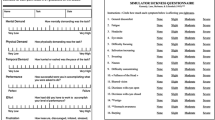Abstract
Purpose
To determine the physical and mental impact on the primary surgeon, by the patient’s and surgical staff’s dispositions at the operating table, during laparoscopic vertical sleeve gastrectomy.
Materials and Methods
This is a randomized and controlled study that included 18 laparoscopic sleeve gastrectomy procedures performed by two surgeons in a private and academic hospital. The cases were randomized for the American or French position. After surgery, the National Aeronautics and Space Administration - Task Load Index (NASA-TLX) and the Body Part Discomfort (BPD) scales were applied to the primary surgeon.
Results
An increased workload and more discomfort were reported when using the French position. The NASA-TLX was 28 ± 8 vs. 57 ± 18 (p = 0.001), and the BPD was 2 vs. 8 (p = 0.001).
Conclusions
The American position resulted in a lower physical and mental impact on the surgeon when performing a laparoscopic sleeve gastrectomy.

Similar content being viewed by others
References
Angrisani L, Santonicola A, Iovino P, et al. Bariatric surgery worldwide 2013. Obes Surg. 2015;25(10):1822–32.
Li JF, Lai DD, Lin ZH, et al. Comparison of the long-term results of Roux-en-Y gastric bypass and sleeve gastrectomy for morbid obesity: a systematic review and meta-analysis of randomized and nonrandomized trials. Surg Laparosc Endosc Percutan Tech. 2014;24(1):1–11.
Zihni AM, Ohu I, Cavallo JA, et al. Ergonomic analysis of robot-assisted and traditional laparoscopic procedures. Surg Endosc. 2014;28(12):3379–8.
Doné, K, DiMartino, A, Judkins, T, Hallbeck, S, Oleynikov D. Evaluation of laparoscopic tools for usability and comfort. Proc Hum Factors Ergon Soc Annu Meet (2004) 48; 12:1359–62.
Park A, Lee G, Seagull FJ, et al. Patients benefit while surgeons suffer: an impending epidemic. J Am Coll Surg. 2010;210(3):306–13.
Angrisani L, Santonicola A, Iovino P, et al. Bariatric surgery and endoluminal procedures: IFSO Worldwide Survey 2014. Obes Surg. 2017;27(9):2279–89.
S. G.Hart, NASA-task load index (NASA-TLX); 20 years later, in Proceedings of the 50th Annual Meeting of the Human Factors and Ergonomics Society (HFES ’06), pp. 904–908, October 2006.
Ruiz-Rabelo JF, Navarro-Rodriguez E, Di-Stasi LL, et al. Validation of the NASA-TLX score in ongoing assessment of mental workload during a laparoscopic learning curve in bariatric surgery. Obes Surg. 2015;25(12):2451–6.
Carswell CM, Clarke D, Seales WB. Assessing mental workload during laparoscopic surgery. Surg Innov. 2005;12(1):80–90.
Corlett E, Bishop R. A technique for assessing postural discomfort. Ergonomics. 1976;19(2):175–82.
Alleblas CC, Velthuis S, Nieboer TE, et al. The physical workload of surgeons: a comparison of SILS and conventional laparoscopy. Surg Innov. 2015;22(4):376–81.
Youssef Y, Lee G, Godinez C, et al. Laparoscopic cholecystectomy poses physical injury risk to surgeons: analysis of hand technique and standing position. Surg Endosc. 2011;25:2168–74.
Van Det MJ, Meijerink WJHJ, Hoff C, et al. Optimal ergonomics for laparoscopic surgery in minimally invasive surgery suites: a review and guidelines. Surg Endosc. 2009;23:1279–85.
Rhee R, Fernandez G, Bush R, et al. The effects of viewing axis on laparoscopic performance: a comparison of non-expert and expert laparoscopic surgeons. Surg Endosc. 2014;28(9):2634–40.
Matern U, Faist M, Kehl K, et al. Monitor position in laparoscopic surgery. Surg Endosc. 2005;19(3):436–40.
Haveran LA, Novitsky YW, Czerniach DR, et al. Optimizing laparoscopic task efficiency: the role of camera and monitor positions. Surg Endosc. 2007;21(6):980–4.
Alleblas CCJ, De Man AM, Van Den Haak L, et al. Prevalence of musculoskeletal disorders among surgeons performing minimally invasive surgery: a systematic review. Ann Surg. 2017;266(6):905–20.
Kramp KH, van Det MJ, Totte ER, et al. Ergonomic assessment of the French and American position for laparoscopic cholecystectomy in the MIS Suite. Surg Endosc. 2014;28(5):1571–8.
Lee SR, Shim S, Yu T, et al. Sources of pain in laparoendoscopic gynecological surgeons: an analysis of ergonomic factors and proposal of an aid to improve comfort. PLoS One. 2017;12(9):e0184400.
Catanzarite T, Tan-Kim J, Whitcomb E, et al. Ergonomics in surgery: a review. Female Pelvic Med Reconstr Surg. 2017;00:00–0.
Hoe VC, Urquhart DM, Kelsall HL, et al. Ergonomic design and training for preventing work-related musculoskeletal disorders of the upper limb and neck in adults. Cochrane Database Syst Rev. 2012;8:CD008570.
Rasotto C, Bergamin M, Simonetti A, et al. Tailored exercise program reduces symptoms of upper limb work-related musculoskeletal disorders in a group of metalworkers: a randomized controlled trial. Man Ther. 2015;20(1):56–62.
Hemal AK, Srinivas M, Charles AR. Ergonomic problems associated with laparoscopy. J Endourol. 2001;15(5):499–503.
Yurko YY, Scerbo MW, Prabhu AS, et al. Higher mental workload is associated with poorer laparoscopic performance as measured by the NASA-TLX tool. Simul Healthc. 2010;5(5):267–71.
Funding
The authors funded the entire research.
Author information
Authors and Affiliations
Corresponding author
Ethics declarations
Conflict of Interest
The authors declare that they have no conflict of interest.
Ethical Approval Statement
All procedures performed in studies involving human participants were in accordance with the ethical standards of the institutional and/or national research committee and with the 1964 Helsinki declaration and its later amendments or comparable ethical standards.
Informed Consent Statement
Informed consent was obtained from all individual participants included in the study.
Rights and permissions
About this article
Cite this article
Carmona, J.E., Higuerey, J.A., Gil, D. et al. Physical and Mental Impact of Laparoscopic Sleeve Gastrectomy on the Surgeon: French vs. American Positions. A Randomized and Controlled Study. OBES SURG 29, 137–142 (2019). https://doi.org/10.1007/s11695-018-3496-1
Published:
Issue Date:
DOI: https://doi.org/10.1007/s11695-018-3496-1




